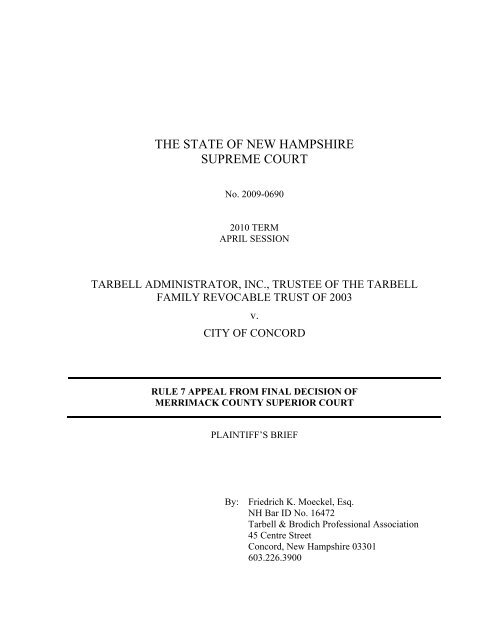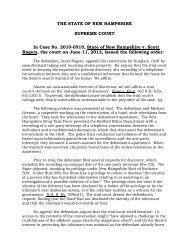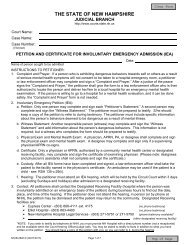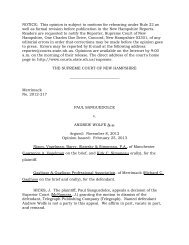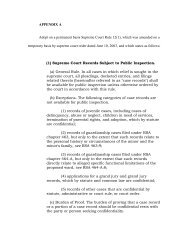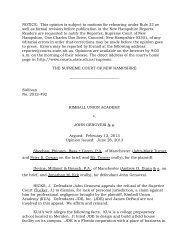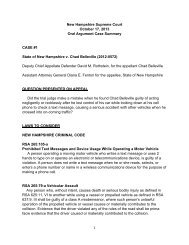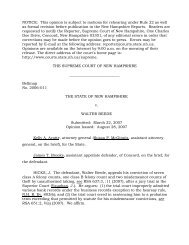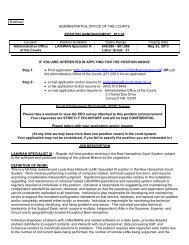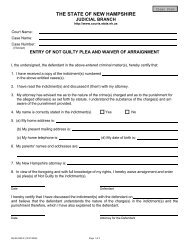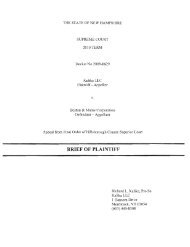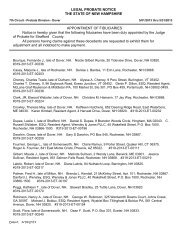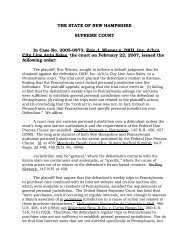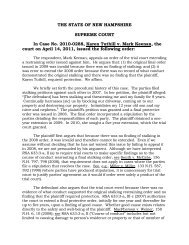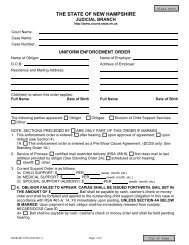THE STATE OF NEW HAMPSHIRE SUPREME COURT
THE STATE OF NEW HAMPSHIRE SUPREME COURT
THE STATE OF NEW HAMPSHIRE SUPREME COURT
You also want an ePaper? Increase the reach of your titles
YUMPU automatically turns print PDFs into web optimized ePapers that Google loves.
<strong>THE</strong> <strong>STATE</strong> <strong>OF</strong> <strong>NEW</strong> <strong>HAMPSHIRE</strong><br />
<strong>SUPREME</strong> <strong>COURT</strong><br />
No. 2009-0690<br />
2010 TERM<br />
APRIL SESSION<br />
TARBELL ADMINISTRATOR, INC., TRUSTEE <strong>OF</strong> <strong>THE</strong> TARBELL<br />
FAMILY REVOCABLE TRUST <strong>OF</strong> 2003<br />
v.<br />
CITY <strong>OF</strong> CONCORD<br />
RULE 7 APPEAL FROM FINAL DECISION <strong>OF</strong><br />
MERRIMACK COUNTY SUPERIOR <strong>COURT</strong><br />
PLAINTIFF’S BRIEF<br />
By: Friedrich K. Moeckel, Esq.<br />
NH Bar ID No. 16472<br />
Tarbell & Brodich Professional Association<br />
45 Centre Street<br />
Concord, New Hampshire 03301<br />
603.226.3900
TABLE <strong>OF</strong> CONTENTS<br />
TABLE <strong>OF</strong> AUTHORITIES ................................................................................................... iii<br />
QUESTIONS PRESENTED......................................................................................................1<br />
<strong>STATE</strong>MENT <strong>OF</strong> <strong>THE</strong> CASE ..................................................................................................3<br />
<strong>STATE</strong>MENT <strong>OF</strong> FACTS.........................................................................................................4<br />
SUMMARY <strong>OF</strong> ARGUMENT .................................................................................................7<br />
ARGUMENT.............................................................................................................................8<br />
I. STANDARD <strong>OF</strong> REVIEW ...............................................................................8<br />
II. <strong>THE</strong> TRIAL <strong>COURT</strong> IMPERMISSIBLY REJECTED ALL FACTS<br />
RELATED TO HOW <strong>THE</strong> CITY CHOSE TO REGULATE/NOT<br />
REGULATE ITS WATER AND <strong>THE</strong> RELEASE <strong>THE</strong>RE<strong>OF</strong> ........................8<br />
A. <strong>THE</strong> TRIAL <strong>COURT</strong> MISINTERPRETED AND MISAPPLIED THIS<br />
<strong>COURT</strong>’S HOLDING IN TARBELL ADM’R, INC. ..................................8<br />
B. <strong>THE</strong> TRIAL <strong>COURT</strong> ERRED IN GRANTING <strong>THE</strong> CITY SUMMARY<br />
JUDGMENT ON <strong>THE</strong> TRUST’S TRESPASS CLAIM...........................10<br />
C. <strong>THE</strong> TRIAL <strong>COURT</strong> ERRED IN GRANTING <strong>THE</strong> CITY SUMMARY<br />
JUDGMENT ON <strong>THE</strong> TRUST’S NUISANCE CLAIM ..........................12<br />
III. PROVING <strong>THE</strong> CITY NEGLIGENTLY MAINTAINED RATTLESNAKE<br />
BROOK AND ITS CULVERTS DOES NOT REQUIRE EXPERT<br />
TESTIMONY ..................................................................................................15<br />
A. STANDARD <strong>OF</strong> REVIEW .......................................................................15<br />
B. <strong>THE</strong> <strong>NEW</strong> <strong>HAMPSHIRE</strong> TEST FOR <strong>THE</strong> NECESSITY <strong>OF</strong> EXPERT<br />
TESTIMONY ............................................................................................17<br />
C. EXTRA-JURISDICTIONAL TESTS FOR <strong>THE</strong> NECESSITY <strong>OF</strong><br />
EXPERT TESTIMONY IN FLOOD CASES ..........................................20<br />
D. THIS CASE DOES NOT REQUIRE EXPERT TESTIMONY ................23<br />
i
IV. <strong>THE</strong> TRIAL <strong>COURT</strong>’S ORDER GRANTING <strong>THE</strong> CITY’S MOTION FOR<br />
SUMMARY JUDGMENT ON <strong>THE</strong> TRUST’S TRESPASS AND<br />
NUISANCES CLAIMS IS A COMPENSABLE UNCONSTITUTIONAL<br />
TAKING <strong>OF</strong> <strong>THE</strong> TRUST’S PROPERTY.....................................................24<br />
CONCLUSION........................................................................................................................26<br />
REQUEST FOR ORAL ARGUMENT AND CERTIFICATION ..........................................27<br />
APPENDIX..............................................................................................................................28<br />
ii
TABLE <strong>OF</strong> AUTHORITIES<br />
Federal Cases<br />
Barnes v. U. S.,<br />
538 F.2d 865 (Ct.Cl. 1976) ................................................................................................24, 25<br />
New Hampshire Cases<br />
Blecatsis v. Manchester Gas Co.,<br />
103 N.H. 542 (1961) ..........................................................................................................17, 18<br />
Boynton v. Figueroa,<br />
154 N.H. 592 (2006) ................................................................................................................16<br />
Brackett v. Bellows Falls Hydro-Electric Corp.,<br />
87 N.H. 173 (1934) ..................................................................................................................11<br />
Burrows v. City of Keene,<br />
121 N.H. 590 (1981) ................................................................................................................24<br />
Carbone v. Tierney,<br />
154 N.H. 521 (2004). ...............................................................................................................18<br />
Dunlop v. Daigle,<br />
122 N.H. 295 (1982)................................................................................................................12<br />
Estate of Joshua T. v. State,<br />
150 N.H. 405 (2003)................................................................................................................15<br />
Estate of Sicotte v. Lubin & Meyer, P.C.,<br />
157 N.H. 670 (2008)................................................................................................................16<br />
Hauser v. Calawa,<br />
116 N.H. 676 (1976)................................................................................................................14<br />
Heston v. Ousler,<br />
119 N.H. 58 (1979)..................................................................................................................12<br />
In re Gronvaldt,<br />
150 N.H. 551 (2004)..........................................................................................................16, 19<br />
Jones v. Tucker,<br />
41 N.H. 546 (1860) ..................................................................................................................21<br />
iii
Lemay v. Burnett,<br />
139 N.H. 633 (1974) ................................................................................................................17<br />
Moulton v. Groveton Papers Co.,<br />
112 N.H. 50 (1972)..................................................................................................................10<br />
Porter v. City of Manchester,<br />
151 N.H. 30 (2004)..................................................................................................................20<br />
Powell v. Catholic Medical Center,<br />
145 N.H. 7 (2000)....................................................................................................................20<br />
Purdie v. Attorney General,<br />
143 N.H. 661, 667 (1999) ........................................................................................................24<br />
Robie v. Lillis,<br />
112 N.H. 492 (1972)................................................................................................................12<br />
Schneider v. Plymouth State College,<br />
144 N.H. 458 (1999) ................................................................................................................16<br />
Silva v. Warden,<br />
150 N.H. 372 (2003)................................................................................................................16<br />
Smith v. HCA Health Serv. of N. H., Inc.,<br />
159 N.H. 158 (2009)................................................................................................................15<br />
Tarbell Adm’r, Inc. v. City of Concord,<br />
157 N.H. 678 (2008)........................................................................................................ passim<br />
Thibault v. Sears, Roebuck & Co.,<br />
118 N.H. 802 (1978)................................................................................................................14<br />
Transmedia Restaurant Co., Inc. v. Devereaux,<br />
149 N.H. 454 (2003)................................................................................................................20<br />
Whitaker v. L.A. Drew, Inc.,<br />
149 N.H. 55 (2003) ............................................................................................................16, 18<br />
White v. Suncook Mills,<br />
91 N.H. 92 (1940)....................................................................................................................10<br />
Wood v. Public Serv. Co. of N.H.,<br />
114 N.H. 182 (1974)..........................................................................................................17, 19<br />
Wong v. Ekberg,<br />
148 N.H. 369 (2002) ................................................................................................................18<br />
iv
Extra-Jurisdictional Cases<br />
City of New Albany v. Charles Barkley,<br />
510 So.2d 805 (Miss. 1987).....................................................................................................22<br />
County of Nueces v. Floyd,<br />
609 S.W.2d 271 (Tex.Civ.App. -Corpus Christi 1980)...........................................................21<br />
Davis v. City of Mebane,<br />
512 S.E.2d 450 (N.C.App. 1999).............................................................................................22<br />
Moore v. Assoc. Material and Supply Co.,<br />
948 P.2d 652 (1999) ....................................................................................................20, 21, 23<br />
Nemet v. Boston Water and Sewer Com’n,<br />
775 N.E.2d 750 (Mass.App.Ct. 2002) .....................................................................................21<br />
San Diego Gas & Electric Co. v. Super. Ct.,<br />
920 P.2d 669 (Cal. 1996).........................................................................................................14<br />
Tarrant Regional Water Dist. v. Gragg,<br />
43 S.W.3d 609 (Tex.App.-Waco 2001) ...................................................................................21<br />
Treatises<br />
Restatement (Second) of Torts § 826 (1979)........................................................................... 13-14<br />
v
QUESTIONS PRESENTED<br />
I. Whether the trial court erred in interpreting Tarbell Adm’r, Inc. v. City of Concord,<br />
157 N.H. 678 (2008) as limiting the City’s liability to its failure to remove debris?<br />
Preserved: Appx. to Brief, (Record “R”) p. 115, 116, 118-19.<br />
II. Whether the trial court erred in interpreting Tarbell Adm’r, Inc., as limiting the<br />
Trust’s trespass and nuisance claims to facts relating to debris as opposed to water?<br />
Preserved: R., pp. 115, 116, 118-19.<br />
III. Whether the trial court erred in interpreting Tarbell Adm’r, Inc., as immunizing all of<br />
the City’s acts and omissions, other than its failure to remove debris?<br />
Preserved: R., pp. 115, 116, 118-19.<br />
IV. Whether the trial court erred in granting the City’s motion for summary judgment on<br />
the Trust’s trespass and nuisance claims, based on the trial court’s conclusion that the<br />
only evidence of the City’s intent related to the City’s control of water, an act the trial<br />
court interpreted immunized by Tarbell Adm’r, Inc.?<br />
Preserved: R., pp. 115, 116.<br />
V. Whether the trial court erred when it concluded that, as a matter of law, the evidence<br />
of substantial and unreasonable interference with the Trust’s use and enjoyment of its<br />
property was insufficient to defend the City’s motion for summary judgment?<br />
Preserved: R., pp. 117, 119.<br />
VI. Whether the trial court applied the proper standard of review and properly analyzed<br />
the City’s motion for summary judgment?<br />
Preserved: R., pp. 111-17.<br />
VII. Whether the trial court applied the correct law to the Trust’s trespass and nuisance<br />
claims? Preserved: R., pp. 114-17, 119-20.<br />
VIII. Whether the trial court erred in concluding that the Trust was required to establish<br />
that the legal cause and cause in fact of the damage to the plaintiff’s property was the<br />
City’s negligent failure to clean out the debris from the brook and culvert and not just<br />
the rainfall itself, and that doing so required an expert?<br />
Preserved: R., pp. 112-14.<br />
IX. Whether the Trust sufficiently preserved its constitutional claims?<br />
Preserved: R., pp. 121.<br />
1
X. Whether the trial court properly granted the City’s motion for summary judgment?<br />
Preserved: R., pp. 108-17.<br />
XI. Whether the trial court properly ignored the City’s deed?<br />
Preserved: R., pp. 71-72, 94-96, 120, 129.<br />
XII. Whether discretionary function immunity permits or justifies a taking in this case, and<br />
whether a taking occurred?<br />
Preserved: R., pp. 121.<br />
XIII. Whether the trial court properly accepted as not shams the City’s alleged maintenance<br />
plan and accompanying affidavits?<br />
Preserved: R., pp. 68-69.<br />
XIV. Whether the trial court properly denied as moot the Trust’s motion for view?<br />
Preserved: R., pp. 131-33.<br />
2
<strong>STATE</strong>MENT <strong>OF</strong> <strong>THE</strong> CASE<br />
This case appears before this Court for a second time. See Tarbell Adm’r, Inc. v. City<br />
of Concord, 157 N.H. 678 (2008). The Plaintiff, Tarbell Administrator, Inc., Trustee of the<br />
Tarbell Family Revocable Trust of 2003 (“Trust”), filed this action against the City of<br />
Concord (“City”) in the Merrimack County Superior Court in November 2006. The City<br />
filed a motion for summary judgment, the trial court granted that motion and the Trust<br />
appealed to this Court. In Tarbell Adm’r, Inc., this Court held the doctrine of discretionary<br />
function immunity only barred two of the Trust’s five claims against the City. Accordingly,<br />
this Court affirmed in part and reversed in part the trial court’s order granting the City’s<br />
motion for summary judgment. This Court also remanded the matter to the trial court.<br />
On remand, the City filed another motion for summary judgment seeking dismissal of<br />
the Trust’s remaining claims. After a hearing, the trial court (Conboy, J) granted summary<br />
judgment to the City. The Trust timely filed a motion for reconsideration and a motion for a<br />
view. The trial court (Smuckler, J) denied those motions. The Trust then appealed to this<br />
Court.<br />
Among other things, this appeal involves the interpretation of Tarbell Adm’r, Inc.<br />
Namely, whether this Court’s decision in that case immunized the City relative to water that<br />
flowed onto and damaged the Trust’s property –irrespective of the theory of recovery. The<br />
trial court concluded Tarbell Adm’r, Inc. altogether immunized the City from claims relating<br />
to water. The trial court also concluded that despite the existence of genuine issues of<br />
material facts, the Trust’s negligence claim required expert testimony on causation and that,<br />
as a matter of law, the Trust’s trespass and nuisance claims failed.<br />
The Trust seeks reversal of the trial court’s grant of summary judgment.<br />
3
<strong>STATE</strong>MENT <strong>OF</strong> FACTS<br />
The Trust owns real property (“Property”) located along North State Street in the city<br />
of Concord. Appendix to Plaintiff’s Brief “Record” (“R.”), p. 50. On the Property sits Mill<br />
Place West, a former mill building converted to a twenty-one unit residential apartment<br />
building. Id. Rattlesnake Brook, the outlet to Penacook Lake, flows through and under the<br />
Property. Id. The Property abuts North State Street, which runs on the Property’s easterly<br />
boundary. Id.<br />
The City owns Penacook Lake, which lies west of the Property. Id. at 43, 50, 98-100.<br />
The City took title to Penacook Lake in 1893. Id. at 94-96. The City’s deed states, among<br />
other things,<br />
Concord Manufacturing Company also covenants that it will permit<br />
the water of said Lake to flow therefrom through its lands on its way<br />
from said Lake to the Merrimack River, providing, that in managing<br />
said water or allowing the same to run to waste, no more water shall be<br />
allowed to flow through the land of the Concord Manufacturing<br />
Company than can be reasonably accommodated by the culvert now<br />
existing, or hereafter constructed across the main highway through<br />
West Concord Village<br />
Id. at 95 (emphasis added). Concord Manufacturing Company granted the City Penacook<br />
Lake. Id. at 94-96. In so doing, Concord Manufacturing Company kept what is now Mill<br />
Place West. Id. at 98-100. Thus, the deed restriction makes sense because, as the<br />
downstream property owner, Concord Manufacturing Company obviously would not want<br />
the City to flood out its buildings and property (Mill Place West). The deed restriction<br />
makes sense for another reason: as the prior owner of Penacook Lake, Concord<br />
Manufacturing Company, like the Trust, recognized that too much water flowing down<br />
Rattlesnake Brook would damage Mill Place West.<br />
4
The City controls and operates a dam and water works at the east end of Penacook<br />
Lake. R. at 3. The dam and its attendant components alter the natural flow of water. Id.<br />
The only outlet for Penacook Lake is Rattlesnake Brook. Id. at 43. As water flows from<br />
Penacook Lake toward the Property it first encounters removable vertical boards which<br />
impound water and also mark the beginning of the dam spillway. Id. at 3, 41. From there,<br />
the water enters Rattlesnake Brook which runs in an easterly-downhill direction out of and<br />
away from Penacook Lake. Id. at 3, 43. Rattlesnake Brook’s course takes it through City<br />
property and culverts on its way to the Merrimack River. Id. at 4, 43. As it exits the<br />
Property, Rattlesnake Brook flows through a culvert under North State Street. Id. As early<br />
as 1981, the City admitted that it was responsible for maintaining this culvert. Id. at 50.<br />
The City has known that water flowing from Penacook Lake through Rattlesnake<br />
Brook was hazardous to the Property and downstream property owners. R., 3-4, 44, 51, 54,<br />
58, 59, 63, 64, 93-96. On numerous occasions since 1990, Eaton W. Tarbell, Jr. wrote the<br />
City advising it that excess water flowing down Rattlesnake Brook could damage the<br />
Property. Id. at 50-51. Mr. Tarbell recommended to the City that it release water in advance<br />
and in anticipation of excessive rainfall. Id. Mr. Tarbell recommended that the City make<br />
controlled releases of water to avoid and prevent uncontrolled discharge which could cause<br />
severe damage to the Property and Mill Place West residents. Id. Concord declined. Id.<br />
Between late 2005 and May 2006, Concord experienced heavy rainfall. R. at 51.<br />
While the rainfall that fell was above normal, the rainfall was predicted. Id. Consistent with<br />
these predictions, in December 2005, the City knew that it was in “wet cycle” so-called and<br />
that it should expect more rainfall. Id. Accordingly, the City’s experts advised it to release<br />
water from Penacook Lake and to inspect Rattlesnake Brook and downstream culverts for<br />
5
debris accumulation and integrity. Id. at 51, 92. Despite Mr. Tarbell’s prior warnings, and<br />
those of its experts, the City neither released water from Penacook Lake in anticipation of<br />
predicted above-normal rainfall nor maintained Rattlesnake Brook and downstream culverts.<br />
Id.<br />
In January 2006, the City knew it had a problem and it sent property owners a letter<br />
that stated “the water level of Penacook Lake was within two tenths of a foot (.2') of<br />
overflowing the spillway and flowing into Rattlesnake Brook.” R. at 51. Despite the<br />
foreseeability of increased water and the damage it could cause, the City did not did not<br />
properly release the waters of Penacook Lake or properly maintain Rattlesnake Brook, which<br />
it could have done. Id. In May 2006, Concord experienced heavy rainfall. Id. Just as Mr.<br />
Tarbell and the City’s experts warned, property damage occurred downstream of Penacook<br />
Lake dam and specifically to the Property. Id. Among others things, the Property suffered<br />
significant damage in excess of $270,000.00 and its residents were displaced. Id.<br />
6
SUMMARY <strong>OF</strong> ARGUMENT<br />
Tarbell Adm’r, Inc. only holds that the City is immune from liability caused by its<br />
negligent design and construction of its dam and its negligent water management. Tarbell<br />
Adm’r, Inc. does not hold that the City is immune from intentional tort liability caused by the<br />
same water. That is, discretionary function immunity does not immunize the City from the<br />
Trust’s trespass and nuisance claims which allege damage caused by water. The trial court’s<br />
decision limiting the Trust’s damages to only those caused by rocks, debris and vegetation<br />
was erroneous.<br />
The Trust properly alleged, and factually supported its trespass and nuisance claims.<br />
The trial court altogether ignored the City’s deed, which prevents it from allowing more<br />
water to flow downstream than the culvert can accommodate. The trial court also misapplied<br />
the law and concluded that the Trust’s evidence was not competent to support its nuisance<br />
claim. The trial court’s decision was, therefore, contrary to the law and facts.<br />
The Trust’s negligence claim (negligent maintenance of water courses) does not<br />
require expert testimony. Indeed, not every case requires an expert. This is such a case.<br />
Other courts deciding the same issue conclude that expert testimony is not required and that<br />
laypeople, and not experts, competently and properly provide the evidence required for a jury<br />
to find causation.<br />
Alternatively, the trial court’s decision permitting the City to flow water over and<br />
through the Trust’s property amounts to an unconstitutional, and compensable taking of the<br />
Trust’s property.<br />
7
I. STANDARD <strong>OF</strong> REVIEW.<br />
ARGUMENT<br />
When reviewing an order on a motion for summary judgment this Court considers the<br />
affidavits and other evidence, and all inferences properly drawn from them, in the light most<br />
favorable to the non-moving party. Tarbell Adm’r, Inc. v. City of Concord, 157 N.H. 678,<br />
682 (2008). In this case the Trust was the non-moving party. If no genuine issue of material<br />
fact existed, and the moving party was entitled to judgment as a matter of law, then summary<br />
judgment should have been granted. Id. This Court reviews the trial court’s application of<br />
the law to the facts de novo. Id.<br />
II. <strong>THE</strong> TRIAL <strong>COURT</strong> IMPERMISSIBLY REJECTED ALL FACTS RELATED<br />
TO HOW <strong>THE</strong> CITY CHOSE TO REGULATE/NOT REGULATE ITS<br />
WATER AND <strong>THE</strong> RELEASE <strong>THE</strong>RE<strong>OF</strong>.<br />
A. <strong>THE</strong> TRIAL <strong>COURT</strong> MISINTERPRETED AND MISAPPLIED THIS<br />
<strong>COURT</strong>’S HOLDING IN TARBELL ADM’R, INC.<br />
In its order granting the City’s motion for summary judgment, the trial court stated<br />
in light of the Supreme Court’s ruling in this case, the only act or<br />
omission for which the City can be liable is its alleged failure to<br />
remove debris from Rattlesnake Brook and its culvert. See Tarbell,<br />
157 N.H. at 685, 687. The Supreme Court has ruled that all of the<br />
other acts or omissions challenged by the plaintiff are entitled to<br />
discretionary function immunity.<br />
R., p. 115. Based on its understanding of Tarbell Adm’r, Inc., the trial court went on to<br />
conclude that the Trust “failed to demonstrate that the City knew that its alleged failure to<br />
remove debris from Rattlesnake Brook and its culvert was ‘substantially certain’ to cause<br />
water and debris to invade the Property” and “[t]he only evidence in the record concerns the<br />
City’s knowledge regarding the injury that could result from the City’s decision not to do a<br />
controlled release of the lake’s water or remove the flashboards -- decisions for which the<br />
City is entitled to discretionary function immunity.” Id. at 115-16.<br />
8
is why.<br />
Respectfully, the trial court misinterpreted and misapplied Tarbell Adm’r, Inc. Here<br />
In Tarbell Adm'r, Inc., this Court held discretionary function immunity immunized<br />
the City’s negligence, not its intentional torts. 157 N.H. at 688. To be sure, the decision<br />
states<br />
[a]s a result of the constitutional implications of such claims [trespass<br />
and nuisance], “while a municipality enjoys immunity for its exercise<br />
of discretion and judgment in the development of a ... plan, such<br />
immunity does not protect it from liability for the creation of a<br />
nuisance or actual trespass.”<br />
Id. (citations and original brackets omitted). Thus, although the City’s liability for its<br />
negligent water management is immunized, the City’s liability for its trespass and nuisance<br />
(intentional torts) from that same water is not immunized. Id. Consequently, the trial court<br />
erred in conflating the legal theories of recovery and excluding from its analysis the facts<br />
relating to the City’s water flooding the Trust’s property that resulted in a trespass and<br />
constitutes a nuisance. Id. In other words, it was contrary to law to focus solely on debris<br />
and altogether ignore the facts about the water that damaged the Trust’s property –damage<br />
that this Court termed “severe.” Id. at 681.<br />
The trial court’s interpretation of Tarbell Adm’r Inc., makes the decision in that case<br />
confusing. This is so because if the trial court correctly interpreted the holding in that case to<br />
altogether immunize the City’s liability relative to water, then there would have been no<br />
reason for this Court to further conclude in that case that discretionary function immunity did<br />
not apply to the Trust’s trespass and nuisance claims. 157 N.H. at 688-89. But, the Trust’s<br />
intentional tort claims allege damage from the same physical matter (water) that formed the<br />
basis of the Trust’s negligence claims (water). The distinction, and key to understanding the<br />
9
trial court’s error is, as this Court noted, that the Trust’s intentional tort claims “are not<br />
restated versions of the negligence claim asserted in count III (negligent failure to<br />
control/regulate water). Id. at 667-68. Rather, they are claims alleging: 1) the deliberate<br />
invasion of the Trust’s property; and 2) that the City used its property in an unlawful and<br />
unreasonable manner. Id. Thus, the Trust’s trespass and nuisance claims properly allege<br />
damage from, among other things, water, and discretionary function immunity does not<br />
preclude the Trust from pointing to water as a fact supporting those two claims. Id. The trial<br />
court’s conclusion to the contrary, was respectfully, not in accordance with this Court’s prior<br />
decision.<br />
B. <strong>THE</strong> TRIAL <strong>COURT</strong> ERRED IN GRANTING <strong>THE</strong> CITY SUMMARY<br />
JUDGMENT ON <strong>THE</strong> TRUST’S TRESPASS CLAIM.<br />
Based on its conclusion that the only facts that could legally support the Trust’s<br />
trespass claim were those related to the City’s alleged failure to remove debris, the trial court<br />
dismissed the Trust’s trespass claim. R., 115-16. The trial court reasoned that “absent<br />
evidence that the City knew that its alleged failure to remove debris from Rattlesnake Brook<br />
and its culvert was ‘substantially certain’ to cause damage to the Property, the [trial c]ourt<br />
rules that the defendant is entitled to summary judgment as a matter of law.” R., 116. As<br />
explained above, the trial court should have also considered the water that damaged the<br />
Trust’s property. Tarbell Adm’r, Inc., 157 N.H. at 667-68.<br />
The Trust properly set forth facts to support its trespass claim. A trespass is an<br />
intentional invasion of the property of another. Moulton v. Groveton Papers Co., 112 N.H.<br />
50, 54 (1972). Involuntary and accidental entries on another’s land are not considered<br />
trespasses. White v. Suncook Mills, 91 N.H. 92, 98 (1940). On the other hand, when an actor<br />
10
knows that an injury is substantially certain to result from its act and it nevertheless<br />
completes the act, it is treated by the law as if it in fact desired to produce the injury. Id.<br />
In this case, the City’s entry onto the Trust’s property was clear and undeniable.<br />
Furthermore, the City’s entry was no accident or involuntary act. The City owns and<br />
operates Penacook Lake. Tarbell Adm’r Inc., 157 N.H. at 679. When Concord took title to<br />
the lake, it did so with a condition. Namely, that “no more water shall be allowed to flow<br />
through the land of the Concord Manufacturing Company than can be reasonably<br />
accommodated by the culvert now existing.” R., 94-96 (emphasis added). The land of the<br />
Concord Manufacturing Company is Mill Place West. Id. at 72, 98-100. The City knew that<br />
it had permission to flow only as much water that Rattlesnake Brook and its culverts could<br />
handle. Id. at 94-96. In January 2006, the City knew that it was in a wet cycle and that if too<br />
much water flowed down Rattlesnake Brook, then damage would occur. Id. at 92. Yet, the<br />
City did nothing. Not surprisingly, when the City let more water flow from the Lake than<br />
Rattlesnake Brook and the culvert could accommodate, water flowed out of the brook and<br />
culvert and onto the Trust’s property outside of Rattlesnake Brook. Id. at 77-76, 81-82. That<br />
was and is a trespass and the City is liable for the damage resulting therefrom.<br />
It would not matter that only one drop of water came out of the culvert, the deed<br />
restriction is clear: the City may not flow more water than the culvert can accommodate. Id.<br />
at 94-96. In this case, more than a drop of water flowed out of the culvert, and that water<br />
damaged the Trust’s property. The rule in New Hampshire is not that a “wrongdoer is liable<br />
only for those consequences of his act which were probable and should have been anticipated<br />
by him when he acted.” Brackett v. Bellows Falls Hydro-Electric Corp., 87 N.H. 173 (1934).<br />
Rather, “[l]iability for the consequences of a tortious act does not depend…upon anticipation<br />
11
y the wrongdoer of the way in which his wrong actually results in harm. In this jurisdiction<br />
‘the question is not whether the damage was foreseen or foreseeable, but whether it in fact<br />
resulted as a direct consequence of the defendants’ act.” Id. (emphasis added). The Trust<br />
properly alleges facts supporting its trespass claim. Furthermore, the City supplied no facts<br />
whatsoever contradicting the Trust’s evidence. Therefore, the trial court erred in granting the<br />
City summary judgment.<br />
C. <strong>THE</strong> TRIAL <strong>COURT</strong> ERRED IN GRANTING <strong>THE</strong> CITY SUMMARY<br />
JUDGMENT ON <strong>THE</strong> TRUST’S NUISANCE CLAIM.<br />
As it did with the Trust’s trespass claim, the trial court limited its analysis of the<br />
Trust’s nuisance claim to those facts involving the City’s failure to remove debris from<br />
Rattlesnake Brook and its culvert. R., 116-17. The trial court also found that the Trust failed<br />
to demonstrate that the City’s alleged failure to remove debris from the culvert was<br />
unreasonable or that it substantially and unreasonably interfered with the Trust’s use of its<br />
property. Id.<br />
“A private nuisance exists when an activity substantially and unreasonably interferes<br />
with the use and enjoyment of another’s property.” Dunlop v. Daigle, 122 N.H. 295, 298<br />
(1982) (citing Heston v. Ousler, 119 N.H. 58, 60 (1979); Robie v. Lillis, 112 N.H. 492, 495-<br />
96 (1972)). “To constitute a nuisance, the defendant’s activity must cause harm that exceeds<br />
‘the customary interferences a land user suffers in an organized society’ and be an<br />
‘appreciable and tangible interference with a property interest.’” Dunlop, 122 N.H. at 298<br />
(citing Robie, 112 N.H. at 495, 496).<br />
Without contradiction, the Trust clearly demonstrated that the City’s acts in this case<br />
were unreasonable and that they also substantially and unreasonably interfered with the<br />
Trust’s enjoyment of its property. R., 76-78. First, the City’s deed sets forth what the Trust’s<br />
12
predecessor in title considered reasonable: “no more water shall be allowed to flow through<br />
the land of the Concord Manufacturing Company than can be reasonably accommodated by<br />
the culvert now existing.” Id. at 94-96 (emphasis added). Concord Manufacturing<br />
Company, like the Trust, was the downstream property owner. Id. at 43, 98-100. Mr.<br />
Tarbell has for years owned, managed and operated commercial and residential properties<br />
and in all of those years he has never encountered a situation like the one at Mill Place West<br />
in 2006. Id. at 76-77. Mill Place West and the property suffered extensive damage due to<br />
Concord’s acts and omissions. Id. at 77-78. As Mr. Tarbell stated “the type of interference<br />
and damage Mill Place West suffered is not the type of interference or damage that I would<br />
customarily suffer or expect to suffer.” Id. at 76-78. He considers the water and other debris<br />
that flowed into and onto Mill Place West, and the damage that the water and other debris<br />
caused to be interferences that he would not expect to encounter in the normal course of<br />
property management, ownership and maintenance. Id. at 78. Again, the City supplied no<br />
facts whatsoever contradicting the Trust’s evidence.<br />
The trial court failed to consider the water that damaged the Trust’s property. As<br />
explained above, this was error. Also, the trial court stated the Trust’s “subjective opinion”<br />
of the type of interference suffered was “insufficient as a matter of law.” R., 117 (citing<br />
Restatement (Second) of Torts § 826 cmt. c). The trial court relied on that comment for the<br />
proposition that the only competent evidence of a substantial and unreasonable interference<br />
with one’s use and enjoyment of his/her property must be from someone other than the<br />
property owner raising the nuisance claim.” R., 117. This was, respectfully, a legal error.<br />
Comment c to § 826 states<br />
The point of view. The unreasonableness of an intentional invasion is<br />
determined from an objective point of view. The question is not<br />
13
whether the plaintiff or the defendant would regard the invasion as<br />
unreasonable, but whether reasonable persons generally, looking at the<br />
whole situation impartially and objectively, would consider it<br />
unreasonable. Consideration must be given not only to the interests of<br />
the person harmed but also for the interests of the actor and to the<br />
interests of the community as a whole. Determining unreasonableness<br />
is essentially a weighing process, involving a comparative evaluation<br />
of conflicting interests in various situations according to objective<br />
legal standards.<br />
Restatement (Second) of Torts § 826 cmt. c. Importantly, the language “whether reasonable<br />
persons generally, looking at the whole situation impartially and objectively, would consider<br />
it unreasonable” means the trier of fact determines reasonableness based on the evidence<br />
before it. See San Diego Gas & Electric Co. v. Super. Ct., 920 P.2d 669, 697 (Cal. 1996)<br />
(citing Restatement (Second) of Torts § 826 cmt. d “Fundamentally, the unreasonableness of<br />
intentional invasions is a problem of relative values to be determined by the trier of fact in<br />
each case in the light of all the circumstances of that case”); also see Thibault v. Sears,<br />
Roebuck & Co., 118 N.H. 802, 809 (1978) (reasonableness is question for trier of fact).<br />
Thus, evidence like that the Trust submitted in opposition to the City’s motion for summary<br />
judgment is altogether competent. Id. It is of no moment that the evidence comes from the<br />
property owner raising the nuisance claim; the trier of fact needs to determine whether, based<br />
on all the evidence, the interference was objectively reasonable. If the trial court were<br />
correct in its statement of the law, then no plaintiff bringing a nuisance claim could<br />
competently testify in support of its claim. That conclusion, however, is not in accord with<br />
the law of this state. Hauser v. Calawa, 116 N.H. 676, 678-79 (1976) (property owners<br />
competently testified to nuisance).<br />
The Trust properly alleges facts supporting its nuisance claim. The trial court’s<br />
decision to grant the City summary judgment on that claim was, therefore, error.<br />
14
III. PROVING <strong>THE</strong> CITY NEGLIGENTLY MAINTAINED RATTLESNAKE<br />
BROOK AND ITS CULVERTS DOES NOT REQUIRE EXPERT<br />
TESTIMONY.<br />
As this Court recognized, the Trust’s negligence claim alleges<br />
that the City “unreasonably invaded Tarbell’s property rights” by<br />
“failing to adequately maintain its water storage systems and outlets<br />
thereto”; specifically, by failing to maintain Rattlesnake Brook and the<br />
culvert through which the brook flows. This claim, however, is not a<br />
restated version of Tarbell’s claim that the City was negligent in<br />
failing to properly control and regulate the water level, and does not<br />
concern the management of the dam and water supply. Rather, Tarbell<br />
alleges that the City's failure to clean out the debris that had collected<br />
in Rattlesnake Brook and the culverts obstructed the flow of water and<br />
caused damage to Tarbell’s property.<br />
Tarbell Adm’r, Inc., 157 N.H. at 687 (internal brackets omitted). The trial court concluded<br />
that that the Trust requires expert testimony to prove the causation element of this claim. R.,<br />
pp. 113-14. Specifically, the trial court stated<br />
an expert will be needed to help the court to assess how much damage<br />
would have occurred even if the City had cleared the brook and culvert<br />
of debris before the flood. An expert will also be needed to help the<br />
court understand whether Rattlesnake Brook would have flooded, but<br />
for the debris that the City allegedly failed to clean out.<br />
R., p. 113. The Trust did not disclose an expert for its negligence claim. Consequently, the<br />
trial court dismissed that claim. Id. at 114. Respectfully, this case does not require an expert<br />
and the trial court’s ruling to the contrary was improper.<br />
A. STANDARD <strong>OF</strong> REVIEW.<br />
This Court’s standard of review regarding this issue is not clear. The question of the<br />
necessity of an expert to prove causation is a question of law and this Court has reviewed the<br />
trial court’s decision on that issue de novo. See Smith v. HCA Health Serv. of N. H., Inc., 159<br />
N.H. 158, 160, 161-62 (2009) (applying de novo review of law to facts in review of summary<br />
judgment on necessity of expert testimony); Estate of Joshua T. v. State, 150 N.H. 405, 407<br />
15
(2003) (same). Similarly, this Court has applied the standard of review used to review a<br />
decision on a motion to dismiss when determining the necessity of expert testimony. Silva v.<br />
Warden, 150 N.H. 372, 373-75 (2003), see also In re Gronvaldt, 150 N.H. 551, 553 (2004)<br />
(in divorce matter this Court indicated it would “sustain [the lower court’s] findings and<br />
rulings unless they are lacking in evidential support or tainted by error of law, applying same<br />
to necessity of expert.)<br />
On the other end of the spectrum is Estate of Sicotte v. Lubin & Meyer, P.C., 157<br />
N.H. 670, 674 (2008). There this Court held that because it is within the sound discretion of<br />
the trial court to dismiss a case for failure to comply with the trial court’s discovery order,<br />
this Court review the trial court decision for an unsustainable exercise of discretion. Id.<br />
Another wrinkle is Boynton v. Figueroa, 154 N.H. 592 (2006). There this Court reviewed<br />
the trial court’s decisions on the admissibility of evidence at trial under an unsustainable<br />
exercise of discretion standard. Id. at 599-600. Yet, when deciding the issue of whether<br />
expert testimony was required at trial, as opposed to admissible at trial this Court made no<br />
indication whether it applied the unsustainable exercise of discretion or de novo standard. Id.<br />
A further complication is Whitaker v. L.A. Drew, Inc., 149 N.H. 55 (2003), where this Court<br />
articulated no standard of review on the issue of the necessity of expert testimony. Whitaker<br />
did, however, apply the unsustainable exercise of discretion standard to its review the trial<br />
court’s discovery sanction, which was to dismiss the case. Id. at 58-59.<br />
At the furthest end of the spectrum is Schneider v. Plymouth State College, 144 N.H.<br />
458 (1999). There, is court reviewed the necessity of expert in the context of a denial of a<br />
motion for directed verdict. That is an “extremely narrow” review. Id. at 463.<br />
16
Consequently, this Court essentially reviewed the trial court’s decision to determine whether<br />
the trial court made a decision that was nonsensical. Id.<br />
De novo review makes sense when considered in light of the underlying analysis of<br />
causation (cause in fact and proximate causation) which are inherently questions of law,<br />
which this Court always reviews de novo. Estate of Joshua T., 150 N.H. at 407. De novo<br />
review also makes sense in this case because, like Smith, 159 N.H. at 160, 161-62 and Estate<br />
of Joshua T., 150 N.H. at 407, this case appears before this court on review of summary<br />
judgment.<br />
B. <strong>THE</strong> <strong>NEW</strong> <strong>HAMPSHIRE</strong> TEST FOR <strong>THE</strong> NECESSITY <strong>OF</strong> EXPERT<br />
TESTIMONY.<br />
New Hampshire has required expert testimony in some circumstances for many years.<br />
See e.g. Blecatsis v. Manchester Gas Co., 103 N.H. 542 (1961). This Court’s existing test for<br />
the necessity of expert testimony has remained unchanged since articulated in Lemay v.<br />
Burnett, 139 N.H. 633 (1974). There, this court stated “[e]xpert testimony is required<br />
whenever the matter to be determined is so distinctly related to some science, profession,<br />
business or occupation as to be beyond the ken of the average layman.” Id. at 635 (citation<br />
and internal quotes omitted). Conversely, expert testimony is not required when this issue is<br />
“within the realm of common knowledge and every-day experience.” Id. at 636; Wood v.<br />
Public Serv. Co. of N.H., 114 N.H. 182, 186 (1974). That is, when the issue is not esoteric,<br />
and instead within the common experience and general observation of laypeople the issue<br />
can be resolved without experts. Wood, 114 N.H. at 188.<br />
The application of this rule falls into three major categories: 1) professional<br />
malpractice cases; 2) medical injury cases; and 3) technical/nontechnical cases. In the first<br />
category, this Court consistently holds that a plaintiff must have expert testimony to prove<br />
17
causation in a professional malpractice case. Estate of Sicotte, 157 N.H. at 674 (expert<br />
required to prove causation in legal malpractice, determination of what fee the trial court<br />
would likely have awarded and what results another attorney would likely have obtained and<br />
how much it would likely have cost on an hourly basis are necessarily so distinctly related to<br />
the legal profession as to be beyond the ken of the average layperson) (internal quotes,<br />
brackets and ellipses omitted); Carbone v. Tierney, 154 N.H. 521 (2004) (expert required to<br />
prove causation even when act is egregious); Wong v. Ekberg, 148 N.H. 369 (2002)<br />
(attorney’s alleged negligent investigation of case; laypeople unfamiliar with discovery<br />
process).<br />
The second category involves those cases where a plaintiff experiences a medical<br />
injury, not caused by a doctor. In these instances this Court’s decisions split depending on<br />
the nature of the harm alleged. For example, when one’s cause of death is heart disease an<br />
expert is required because heart disease itself is subtle, and not within common knowledge.<br />
Blecatsis, 103 N.H. at 544. The Blecatsis court also noted that an expert was required<br />
because the plaintiff’s theory was that the decedent’s employment caused his death. Id. That<br />
attenuation required expert testimony for causation. Id. Similarly, a plaintiff attempting to<br />
recover for wrongful death because of suicide must have expert testimony. Estate of Joshua<br />
T., 150 N.H. at 408-09. This is so because suicide is inherently not easily understood. Id. at<br />
408. Also, when a plaintiff alleges a “medical injury” under RSA 507-E:1, then RSA 507-<br />
E:2 requires expert testimony to prove causation. Smith, 159 N.H. at 160.<br />
The third category of cases deal with technical/nontechnical issues. When the<br />
underlying issue is inherently technical, this Court requires expert testimony. Whitaker, 149<br />
N.H. at 57; Lemay, 139 N.H. at 636. In Whitaker causation turned on the issue of the lack of<br />
18
properly functioning brakes on a vibratory pavement roller. 149 N.H. at 57. This Court held<br />
that “the operation of construction equipment with complex hydrostatic transmissions is not<br />
within the common experience of jurors.” Id. Thus, an expert was required. Id. In Lemay,<br />
causation hinged on the physics of human interaction with diving boards and water, an<br />
inherently technical subject. 139 N.H. at 636. Therefore, an expert was required for<br />
causation. Id.<br />
Examples of nontechnical issues that do not require expert testimony are those<br />
situations where human observation and experience provide laypeople the foundation to<br />
understand causation. For instance, Wood involved the fatal electrocution of a man on an<br />
aluminum ladder that contacted a 7,200 volt power line. 103 N.H. at 184-85. The defendant<br />
power company argued that the physics of electricity and its arcing tendencies necessarily<br />
required expert testimony. Id. at 186. This Court disagreed with the defendant and held no<br />
expert testimony was required to prove causation. Id. The Court reasoned that while the<br />
physics and arcing of electricity is complicated, the plaintiff’s case did not require such<br />
expert testimony for the simple reason that the decedent physically touched the power line.<br />
Put another way, human contact with 7200 volts and the effects that causes is not so esoteric<br />
to beyond the ken of the average person. Id. Similarly, when people observe events and the<br />
causes and consequences are apparent, experts are not required. In Boyton, this Court held<br />
that a plaintiff-homeowner who actually observed structural and other defects and flaws in<br />
his home, which was built by defendant-contractor, did not need expert testimony to establish<br />
causation. 154 N.H. at 600-01. Other examples of nontechnical issues not requiring expert<br />
testimony are those where a layperson can testify to the emotional harm caused by physical<br />
threats, or dangerous actions. In re Gronvaldt, 150 N.H. at 554 (systematic abusive conduct<br />
19
does not require expert for causation on emotional harm); Silva, 150 N.H. at 375 (no expert<br />
required to prove harm from unprivileged physical contact); Powell v. Catholic Medical<br />
Center, 145 N.H. 7, 14 (2000); see also Schneider, 144 N.H. at 464 (concepts of fiduciary<br />
relationship do not require expert testimony to explain them to jury); Transmedia Restaurant<br />
Co., Inc. v. Devereaux, 149 N.H. 454, 460-61 (2003) (expert not required for valuation of<br />
restaurant equipment when witness has personal knowledge of value); and Porter v. City of<br />
Manchester, 151 N.H. 30, 45-46 (2004) (employee’s personal knowledge of salary sufficient<br />
to prove lost earnings, expert testimony not required).<br />
C. EXTRA-JURISDICTIONAL TESTS FOR <strong>THE</strong> NECESSITY <strong>OF</strong> EXPERT<br />
TESTIMONY IN FLOOD CASES.<br />
This Court has never decided whether a plaintiff, like the Trust, must present expert<br />
evidence to prevail on the types of claims in this case. Other courts have. They hold that a<br />
plaintiff need not present expert testimony to establish its claims. For instance, in its<br />
decision on facts similar to this case, the Kansas Supreme Court declined to require expert<br />
testimony to prove causation. Moore v. Assoc. Material and Supply Co., 948 P.2d 652, 663<br />
(1999). Moore involved a complicated artificial levee built alongside a subdivision that sat<br />
alongside the Arkansas River. Id. at 655-56. The plaintiffs sought to rely on lay testimony to<br />
support their claims. Id. at 658.<br />
Among other initial matters, the Moore court recognized that “[a]lthough expert<br />
witnesses may be permitted in some cases to testify on the basis of necessity, this does not<br />
necessarily mean that an expert would be required. Id. at 559. And more poignantly<br />
[w]hile the testimony of witnesses having specialized education and<br />
training, or special experience and knowledge, is often admitted into<br />
evidence on the ground of necessity, a party is not necessarily required<br />
to resort to expert opinion testimony merely because the case involves<br />
matters of science, special skill, special learning, knowledge, or<br />
experience which may be difficult for jurors to comprehend.<br />
20
Id. at 660.<br />
The Moore court then analyzed and surveyed cases from several states on this issue.<br />
Id. at 658-62. Resolving the expert testimony issue in favor of the plaintiff and concluding<br />
expert testimony was not required, the Moore court pointed to the fact that where, as in this<br />
case, witnesses see the water flowing from one location to another and see the before-and-<br />
after, so-called, the causal nature of the action is self-evident. Id. at 661. Accordingly,<br />
expert testimony is not required and the matter is properly submitted to the jury without it.<br />
Id. see also County of Nueces v. Floyd, 609 S.W.2d 271, 276 (Tex.Civ.App. -Corpus Christi<br />
1980) (expert testimony not required for causation on flooding; lay people properly testify as<br />
to conditions observed, and other things visible). Another case –in Massachusetts– held that<br />
expert testimony is not required to prove claims similar to those in this case. Nemet v.<br />
Boston Water and Sewer Com’n, 775 N.E.2d 750, 755 (Mass.App.Ct. 2002) review denied<br />
777 N.E.2d 1264 (Mass. 2002). In rejecting an argument like the one the City makes in this<br />
case, the Nemet court identified that the negligent maintenance of a sewer or culvert is not<br />
technical in nature and, therefore, does not require expert testimony for causation. 775<br />
N.E.2d at 755 (citing with approval to Moore, supra and Tarrant Regional Water Dist. v.<br />
Gragg, 43 S.W.3d 609 (Tex.App.-Waco 2001) (credible lay testimony is proper to establish<br />
causation)).<br />
The Trust recognizes that some courts have held a plaintiff requires expert testimony<br />
to go forward with claims like those the Trust alleges against the City. Those cases are,<br />
however, inapposite and distinguishable. The distinction rests in how these courts determine<br />
whether an expert is needed in the first instance. It is true that one may, through continuous<br />
work or study in a specified area or field, become an expert. Jones v. Tucker, 41 N.H. 546<br />
21
(1860). The opposite is not true: one’s status as an expert in a specified area or filed does not<br />
lead to the conclusion that his testimony is required to prove causation. Yet, this is, in part,<br />
what the City argues here. As revealed below, although the City baldly claims this case<br />
requires expert testimony, the City’s assertion is not enough to get the proverbial ball rolling.<br />
In 1987, the Mississippi Supreme Court held that a plaintiff, like the trust, required<br />
expert testimony to prevail on its claim that a municipality negligently maintained its<br />
culverts. City of New Albany v. Charles Barkley, 510 So.2d 805, 806 (Miss. 1987). Like the<br />
City in this case, the City of New Albany asserted that Mr. Barkley’s claim required expert<br />
testimony, the absence of which was fatal to his case. Id. at 806-07. The trial court and<br />
Mississippi supreme court agreed. Id. The key distinction is that the defendant municipality<br />
demonstrated, through its own expert, that expert evidence was required to prove the<br />
plaintiff’s case. Id. A few years later in another part of the South, and in another claim by a<br />
property owner against a municipality a similar result occurred. Davis v. City of Mebane,<br />
512 S.E.2d 450 (N.C.App. 1999). The City of Mebane moved to dismiss the plaintiff’s claim<br />
of negligent dam construction Davis’ claim because Davis relied on lay testimony regarding<br />
differences in water levels before and after the installation of the dam. Id. at 504. The trial<br />
court and court of appeals rejected the plaintiff’s claims because the defendant’s experts<br />
contradicted the plaintiff’s claim that lay testimony could prove causation. Id. Thus, a<br />
plaintiff might be required to present expert testimony on causation if a defendant, through<br />
expert testimony, first independently demonstrates that the plaintiff’s lay testimony is<br />
insufficient to prove causation.<br />
22
D. THIS CASE DOES NOT REQUIRE EXPERT TESTIMONY.<br />
In this case, the City, and respectfully, the trial court, relied on speculation and<br />
conjecture to conclude expert testimony is required. Indeed, the City baldly asserted that<br />
experts are required to determine:<br />
• “how the flooding occurred”<br />
• “how much water Rattlesnake Brook can hold”<br />
• “how much water retention there is under normal circumstances”<br />
• “how much water there would be during a historic meteorological<br />
event like the Mother’s Day flood”<br />
• “the causal connection between the backup of the water due to the<br />
allegedly clogged culvert verses [sic] the increase in the water due to<br />
the storm”<br />
R., p. 13.<br />
This case is like Wood, Moore and Nemet. Contrary to the City’s bald assertions, this<br />
case does not involve the complexities of hydraulics or physics. The facts are undisputed,<br />
and undisputedly straightforward: water from the City’s property flooded the Trust’s<br />
property. That water damaged the Trust’s property. The City admits that its water damaged<br />
the Trust’s property. Humans have been watching water since the dawn of time; our<br />
civilizations revolve around it. At summary judgment, the Trust analogized its negligence<br />
claim to a bathtub with a clogged drain. It when like this: everybody knows that when a<br />
drain is clogged and the faucet remains on, water will flow where it is not supposed to go.<br />
The trial court disagreed with the Trust’s analogy. Yet, in this case the culverts were clogged<br />
and the water kept running. In fact, a lot of water kept running. The clog was so bad the<br />
City needed a backhoe to try to remove it. The Trust’s property flooded. Thus, contrary to<br />
the City’s assertion, this is not a complicated case.<br />
There are machines called the Rube Goldberg machines. These machines are<br />
deliberately designed to make an ordinarily simple tasks excruciatingly complicated. The<br />
23
City’s assertion that this case requires expert testimony is analogous to a Rube Goldberg<br />
machine. Moore, 948 P.2d at 660 (While the testimony of witnesses having specialized<br />
education and training, or special experience and knowledge, is often admitted into evidence<br />
on the ground of necessity, a party is not necessarily required to resort to expert opinion<br />
testimony merely because the case involves matters of science). The issues in this case are<br />
not so esoteric and technical that they require expert testimony. The evidence in the record<br />
indicates that the lay witnesses saw the City’s water flood and damage the Trust’s property.<br />
These issues are not beyond the ken of the average person. Therefore, expert testimony is<br />
not required and the trial court erred in holding otherwise and dismissing the Trust’s<br />
negligence claim.<br />
IV. <strong>THE</strong> TRIAL <strong>COURT</strong>’S ORDER GRANTING <strong>THE</strong> CITY’S MOTION FOR<br />
SUMMARY JUDGMENT ON <strong>THE</strong> TRUST’S TRESPASS AND NUISANCES<br />
CLAIMS IS A COMPENSABLE UNCONSTITUTIONAL TAKING <strong>OF</strong> <strong>THE</strong><br />
TRUST’S PROPERTY.<br />
“No man’s property may be taken from him without just compensation.” Burrows v.<br />
City of Keene, 121 N.H. 590, 595 (1981). This rule applies to governmental takings of<br />
private property. Id. at 596 (citing N.H.Const. pt. I, art. 12). Property rights created by the<br />
common law may not be taken away without due process of law. Purdie v. Attorney<br />
General, 143 N.H. 661, 667 (1999). A “plaintiff need not allege or prove that defendant<br />
specifically intended to take property. There need be only a governmental act, the natural and<br />
probable consequences of which effect such an enduring invasion of plaintiffs’ property as to<br />
satisfy all other elements of a compensable taking.” Barnes v. U. S., 538 F.2d 865, 871<br />
(1976). In this case this Court has already recognized the constitutional implications of<br />
inverse condemnation absent a remedy for the Trusty relative to the City’s actions. Tarbell<br />
Adm’r, Inc., 157 N.H. at 688.<br />
24
Despite these rules, the trial court granted summary judgment in favor of the City on<br />
the Trust’s trespass and nuisance claims. Consequently, the trial court deprived the Trust of<br />
any remedy against the City for its unlawful use of the Trust’s property for a governmental<br />
purpose. Tarbell Adm’r, Inc., 157 N.H. at 688. To be sure, in this case the City, without the<br />
right, flowed water onto the Trust’s property, to the damage of the Trust. Consequently, the<br />
trial court authorized the City’s taking of the Trust’s private property for the City’s purposes.<br />
That is, despite the Trust’s common law property rights, and the City’s common law deed<br />
restriction limiting the amount of water the City may flow through the Trust’s property, the<br />
trial court’s order permits the City to flood the Trust’s property without compensating the<br />
Trust for that right. That result “violates the prohibition in Part I, Article 12 of the State<br />
Constitution and the Fifth Amendment of the Federal Constitution against the taking of<br />
property for public use without just compensation.” Purdie, 143 N.H. at 667. Thus,<br />
analogous to Barnes supra, where the government’s intermittent flooding of the plaintiff’s<br />
property amounted to a compensable flowage easement, here too, the City has taken a<br />
flowage easement from the Trust without compensation. The Trust is, therefore, entitled to<br />
its damages. Id.<br />
25
CONCLUSION<br />
The trial court misinterpreted this Court’s decision in Tarbell Adm’r, Inc.<br />
Consequently, the trial court too narrowly focused on the City’s liability relative to debris as<br />
opposed to water, rocks and debris –all of which caused damage the Trust’s property,<br />
negligently and intentionally. The trial court also, inexplicably ignored the City’s deed,<br />
which on its face restricts the amount of water the City may permissibly flow through the<br />
Trust’s property. The trial court also erred in granting the City summary judgment on the<br />
Trust’s trespass and nuisance claims. These are all reversible errors.<br />
The trial court all erroneously concluded that the Trust’s negligence claim is<br />
complicated that laypeople cannot understand what happened. This conclusion is not<br />
consistent with this Court’s rulings on the necessity of expert witnesses or those of other<br />
courts when dealing with flood claims.<br />
The trial court’s decision also permits an unconstitutional, and compensable taking of<br />
the Trust’s property.<br />
court’s order.<br />
For all of these reasons, the Trust’s respectfully requests this Court to reverse the trial<br />
26
Respectfully submitted,<br />
Tarbell Administrator, Inc., Trustee of<br />
The Tarbell Family Revocable Trust Of 2003<br />
By its attorneys,<br />
Tarbell & Brodich Professional Association<br />
Dated: April 22, 2010 By: ___________________________<br />
Friedrich K. Moeckel, Esquire<br />
Tarbell & Brodich Professional Association<br />
45 Centre Street<br />
Concord, New Hampshire 03301<br />
603.226.3900<br />
REQUEST FOR ORAL ARGUMENT AND CERTIFICATION<br />
Tarbell Administrator, Inc., Trustee of The Tarbell Family Revocable Trust of 2003<br />
requests that its attorney Friedrich K. Moeckel be allowed 15 minutes for oral<br />
argument.<br />
I hereby certify that on April 22, 2010 two copies of the foregoing Brief and Appendix<br />
to Brief were forwarded to counsel for Defendant City of Concord:<br />
Charles P. Bauer, Esquire<br />
Gallagher, Callahan & Gartrell<br />
214 North Main Street<br />
P.O. Box 1415<br />
Concord, New Hampshire 03302-1415<br />
603.228.1181<br />
Dated: April 22, 2010 ________________________<br />
Friedrich K. Moeckel, Esquire<br />
Tarbell & Brodich Professional Association<br />
45 Centre Street<br />
Concord, New Hampshire 03301<br />
603.226.3900<br />
27
APPENDIX<br />
1. Trial court order on summary judgment ..........................................................................29<br />
2. Trial court order on motion for reconsideration ..............................................................40<br />
28


